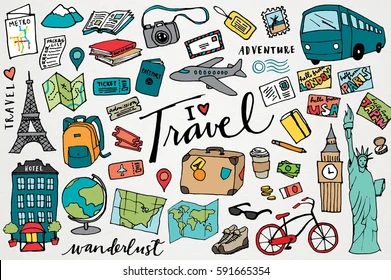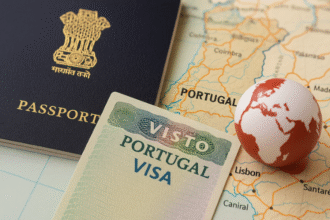The Comprehensive Guide to Travel Clipart
Travel has a way of igniting our wanderlust, inspiring us to explore new places and cultures. But what if you could capture that spirit in your designs? Enter travel clipart—an enchanting blend of creativity and adventure that can transform your projects into visual storytelling masterpieces.
Imagine adding vibrant illustrations of iconic landmarks, whimsical suitcases, or serene beach scenes to your travel blogs, brochures, or social media posts. Travel clipart not only enhances the aesthetic appeal but also evokes emotions tied to exploration and discovery.
Whether you’re a seasoned designer or simply looking to add some flair to your personal projects, understanding the world of travel clipart is essential. This guide will take you through everything you need to know about travel clipart—from types and uses to where you can find high-quality options. So grab your virtual passport as we embark on this creative journey!
What is Travel Clipart?
Travel clipart refers to illustrations and graphics that capture the essence of travel. These images can range from simple icons, like airplanes and luggage, to detailed scenes depicting famous landmarks or picturesque landscapes.
Graphic designers and enthusiasts use travel clipart in various projects, including websites, flyers, invitations, and presentations. This visual element adds depth while conveying a sense of adventure.
The charm of travel clipart lies in its versatility. Whether you’re designing a postcard for friends or crafting an itinerary brochure for clients, these visuals bring life to your concepts.
In today’s digital age, incorporating captivating imagery is vital for grabbing attention. Travel clipart serves as an effective tool to enhance storytelling with vibrant representations of destinations around the globe.
Types of Travel Clipart
Travel clipart comes in a variety of styles, catering to different themes and tastes.
One popular type is hand-drawn clipart. This style adds a personal touch with its artistic flair, perfect for travel journals or blogs that want a whimsical feel.
Vector graphics are another option. These images are scalable without losing quality, making them ideal for larger projects like posters or flyers.
For those who prefer realism, photographic clipart provides stunning visuals that capture the essence of destinations. They work well in presentations or promotional materials.
Icons represent yet another category. Simple and clean, these symbols quickly convey ideas such as transport modes or famous landmarks.
Themed bundles offer curated sets focusing on specific aspects of travel—think beach vacations or adventure trips—making it easy to maintain consistency across your design projects. Each type serves unique purposes while enhancing your creative expression.
How to Use Travel Clipart
Travel clipart can elevate your projects, making them visually appealing and engaging. Start by selecting images that resonate with your theme or destination. Whether it’s colorful landmarks, travel icons, or whimsical illustrations, the right choice sets the tone.
Next, integrate these images into various formats—brochures, websites, social media posts. Use software like Canva or Adobe Illustrator for easy manipulation and layering of clipart.
Consider color schemes to ensure harmony between text and graphics. A well-matched palette enhances visual flow.
Don’t shy away from using transparency effects for a modern touch. This technique helps blend clipart seamlessly into backgrounds.
Remember to maintain consistent styles throughout your project. Uniformity strengthens branding and gives a polished finish to your work.
Benefits of Using Travel Clipart
Travel clipart offers a vibrant way to enhance your design projects. Whether you’re creating brochures, presentations, or social media posts, these visuals can instantly grab attention.
They simplify complex ideas by illustrating concepts like destinations or activities. This makes it easier for your audience to understand and engage with your content.
Using travel clipart also saves time. Instead of spending hours searching for the perfect photo, you can find a suitable clipart image quickly. This efficiency allows more focus on the message rather than the visuals.
Moreover, travel clipart is often more versatile than traditional photography. You can resize or modify them without losing quality, making them ideal for various formats and platforms.
They bring an artistic flair to your work. Unique styles and colors in clipart provide a refreshing touch that photographs might not achieve as effectively.
Where to Find High-Quality Travel Clipart
Finding high-quality travel clipart can be a breeze if you know where to look. Numerous online platforms cater specifically to graphics enthusiasts.
Stock image websites like Shutterstock and Adobe Stock offer extensive libraries of professionally designed travel clipart. You’ll find everything from airplanes to beach scenes, all in one place.
There are also dedicated design resources such as Freepik and Vecteezy, providing both free and premium options. These sites often feature user-generated content that brings fresh perspectives.
For something unique, consider browsing Etsy or Creative Market. Independent artists sell their designs here, allowing for more personalized choices.
Social media platforms like Pinterest can inspire you too! Search for travel clipart boards; many artists share their work there with direct links to purchase or download.
Don’t overlook the power of Google Images—just remember to filter results by usage rights for ethical sourcing.
Tips for Choosing the Right Travel Clipart for Your Project
When selecting travel clipart, start by defining your project’s theme. Whether it’s adventure, relaxation, or cultural exploration, the imagery should reflect that essence.
Consider your audience as well. Are they families seeking fun vacations or solo travelers looking for inspiration? Tailoring your choices to their preferences will enhance engagement.
Quality matters significantly. Opt for high-resolution images to ensure crisp visuals in both digital and print formats.
Don’t overlook color schemes. Choose clipart that complements your existing palette to create a cohesive look across all materials.
Keep versatility in mind. Select pieces you can adapt for various platforms and uses—social media posts, brochures, or websites—to maximize value from each design element.
Creative Ways to Incorporate Travel Clipart into Your Designs
Integrating travel clipart into your designs can breathe life into any project. Consider using it in social media graphics to create eye-catching posts that resonate with wanderlust.
For presentations, sprinkle relevant clipart throughout your slides. This adds visual interest and reinforces your message about adventures or destinations.
If you’re designing a travel blog, use clipart as headers or section dividers. It helps maintain a cohesive theme while engaging readers visually.
Create unique invitations for travel-themed events by incorporating playful icons of airplanes or suitcases. These small details elevate the overall aesthetic.
Think about merchandise design like shirts or tote bags. Travel clipart can transform simple items into conversation starters, sparking joy among fellow explorers.
Legal Considerations When Using Travel Clipart
When using travel clipart, understanding copyright laws is crucial. Most images are protected by intellectual property rights. Always check the licensing agreement before use.
Public domain images can be a safe choice. They don’t have restrictions and can be used freely. However, verify that they truly belong to this category.
Attribution may be necessary for certain clipart sources. Crediting the original creator not only respects their work but often adheres to usage requirements.
Consider commercial use as well if you plan to monetize your project. Some licenses limit how you can use the artwork in commercial settings.
Keep an eye on modifications. Altering clipart could lead to different legal implications depending on its license type. Make sure any changes comply with established guidelines for each piece of art you choose to use.
Conclusion
Travel clipart serves as a vibrant tool for anyone looking to enhance their visual storytelling. It adds personality and flair to various projects, from travel blogs to marketing materials.
With countless resources available, finding the right images can elevate your designs significantly.
Experimenting with different styles and themes can spark creativity in unexpected ways. The versatility of clipart allows you to tailor visuals that resonate with your audience.
As you dive into using travel clipart, consider both aesthetic appeal and legal aspects. This thoughtful approach will ensure your project stands out while respecting creators’ rights.
The journey of incorporating these graphics is just as exciting as the destinations they represent. Embrace the adventure that comes with every design choice you make!
FAQs
Q: What is travel clipart?
A: Travel clipart refers to various digital illustrations, icons, and graphics that represent travel-related themes. These can include images of landmarks, modes of transportation, luggage, and other elements associated with traveling.
Q: Where can I find free travel clipart?
A: There are many websites offering free travel clipart. Sites like Pixabay, Unsplash, and Freepik provide a wide range of options. Make sure to check the licensing agreements before using any artwork.
Q: Can I use travel clipart for commercial projects?
It depends on the licensing terms of the specific piece you choose. Some sources offer royalty-free images for commercial use while others may require attribution or have restrictions. Always read the fine print.
Q: How do I incorporate travel clipart into my designs?
A: You can embed it in flyers, brochures, blogs about destinations or even social media posts promoting your latest trips or services related to tourism.
Q: Is there a difference between vector art and raster images when it comes to travel clipart?
A: Yes! Vector art consists of paths defined by mathematical expressions allowing them to be scaled without losing quality. Raster images are pixel-based; scaling them too much can lead to distortion or blurriness.
Q: What software can I use to edit travel clipart?
A: Popular graphic design software such as Adobe Illustrator and Photoshop works well for editing both vector and raster graphics. There are also user-friendly alternatives like Canva that cater specifically to beginners.
Q: Can I create my own custom travel clipart?
A: Absolutely! If you’re artistically inclined or have access to design software, creating your own custom pieces allows you complete creative control over how they look in your project.
Q: Are there any copyright issues with using online generated content for creating new designs?
A: Using content from online sources requires careful adherence to copyright laws. It’s essential always verify permissions granted through licenses regarding adaptations or modifications before proceeding with personal creations based on existing artworks.
















